Pterodactylus
| Pterodactylus Temporal range: Late Jurassic, 150.8–148.5Ma | |
|---|---|
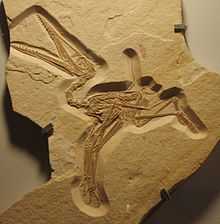 | |
| Specimen in Bürgermeister Müller Museum | |
| Scientific classification | |
| Kingdom: | Animalia |
| Phylum: | Chordata |
| Order: | †Pterosauria |
| Family: | †Pterodactylidae |
| Genus: | †Pterodactylus Cuvier, 1809 |
| Type species | |
| †Ornithocephalus antiquus Sömmerring, 1812 | |
| Species | |
|
†Pterodactylus antiquus | |
| Synonyms | |
|
Species synonymy
| |
Pterodactylus (/ˌtɛrəˈdæktɨləs/ TERR-ə-DAK-til-əs, from the Greek πτεροδάκτυλος, pterodaktulos, meaning "winged finger") /ˌtɛrəˈdæktɨl/) is a genus of pterosaurs, whose members are popularly known as pterodactyls. It was the first to be named and identified as a flying reptile. Its fossil remains have been found primarily in the Solnhofen limestone of Bavaria, Germany, dated to the late Jurassic Period (early Tithonian), about 150.8–148.5 million years ago,[1] though more fragmentary remains have been identified from elsewhere in Europe and in Africa. It was a carnivore and probably preyed upon fish and other small animals. Like all pterosaurs, the wings of Pterodactylus were formed by a skin and muscle membrane stretching from its elongated fourth finger to its hind limbs. It was supported internally by collagen fibres and externally by keratinous ridges.
The name derives from the Greek words pteron (πτερόν, meaning 'wing') and daktylos (δάκτυλος, meaning 'finger') and refers to the way in which the wing is supported by one large finger.
Description

Pterodactylus is known from over 27 fossil specimens, and though most of those are juveniles, many preserve complete skeletons.[2] The discovery of several specimens with well-preserved soft tissue traces has allowed scientists to faithfully reconstruct the life appearance of Pterodactylus. Pterodactylus was a relatively small pterosaur, with an estimated adult wingspan of about 1.5 meters (5 ft) in P. antiquus.[2] Other "species" were once thought to be smaller. However, these smaller specimens have been shown to represent juveniles of Pterodactylus, as well as its contemporary relatives Ctenochasma, Germanodactylus and Gnathosaurus.[3]
The skulls of adult Pterodactylus were long and narrow with about 90 large, conical teeth. The teeth extended back from the tips of both jaws, and became smaller farther away from the jaw tips (unlike some relatives, where teeth were absent in the upper jaw tip and were relatively uniform in size). The teeth extended farther back into the jaw than in close relatives, as some were present below the front of the nasoantorbital fenestra, the largest opening in the skull. Unlike related species, the skull and jaws were straight, not curved upwards.[4] A small, hooked beak was present in the very tips of the jaws, with both upper and lower hook no larger than the teeth that surrounded them.[5]
The neck was long, and covered in long, bristle-like pycnofibres. A throat pouch extended from about the middle of the lower jaw to the upper part of the neck.[6]
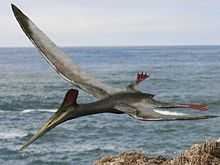
Pterodactylus, like related pterosaurs, had a crest on its skull composed mainly of soft tissues. In adult Pterodactylus, this crest extended between the back edge of the antorbital fenestra (the largest opening in the skull) and the back of the skull. The back of the crest extended upward into a backward-curving cone-shaped structure. The crest was composed mainly of long, hardened fibres (twisted together in a spiral pattern inside the conical part of the crest), and covered in scales. In at least one specimen, the crest had a short bony base, also seen in related pterosaurs like Germanodactylus. Solid crests have only been found on large, fully adult specimens of Pterodactylus, indicating that this was a display structure that became larger and more well developed as individuals reached maturity.[6] MCZ 1505, a specimen of Pterodactylus antiquus, had a roughly triangular soft tissue crest extending upward above the posterior half of the naso-antorbital fenestra and the orbit; the crest was 44 to 51 mm long (around 38 to 45% of the total length of the skull) and reached a maximum height of 9,5 mm.[7] Bennett (2013) noted that other authors claimed that the soft tissue crest of Pterodactylus extended backward behind the skull; Bennett himself, however, didn't find any evidence for the crest extending past the back of the skull.[7] Two specimens of P. antiquus (the holotype specimen BSP AS I 739 and the incomplete skull BMMS 7, the largest known skull of P. antiquus) have a low bony crest on their skulls; in BMMS 7 it is 47.5 mm long (more or less 24% of the estimated total length of its skull) and has a maximum height of 0.9 mm above the orbit.[7]
The wings were long, and the wing membranes appear to have lacked the furry covering of pycnofibres present in some other pterosaurs (such as Pterorhynchus and Jeholopterus). The wing membrane extended between the fingers and toes as webbing, and a uropatagium (secondary membrane between the feet and tail) was present, as well as a propatagium (membrane between the wrist and shoulder).[6] Both the finger and toe claws were covered in keratin sheaths that extended and curved into sharp hooks well beyond their bony cores.[5]
Paleobiology
Year classes
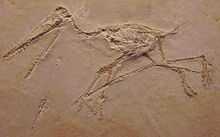
Like other pterosaurs (notably Rhamphorhynchus), Pterodactylus specimens can vary considerably based on age or level of maturity. Both the proportions of the limb bones, size and shape of the skull, and size and number of teeth changed as the animals grew. Historically, this has led to various growth stages (including growth stages of related pterosaurs) being mistaken for new species of Pterodactylus. Several detailed studies using various methods to measure growth curves among known specimens have demonstrated that there is actually only one valid Pterodactylus species, P. antiquus.[4]

The youngest immature Pterodactylus specimens have a small number of teeth (as few as 15), and the teeth have a relatively broad base.[2] The teeth of older specimens are both narrower and more numerous (up to 90 teeth are present in some specimens).[4]
Pterodactylus specimens can be divided into two distinct year classes. In the first year class, the skulls are only 15-45mm in length. The second year class is characterized by skulls 55-95mm long, but still immature. These first two size groups were once classified as juveniles and adults of the species P. kochi, until further study showed that even the supposed "adults" were immature. A third year class is represented by specimens of the "traditional" P. antiquus, as well as a few isolated, large specimens once assigned to P. kochi that overlap P. antiquus in size. However, all specimens in this third year class also show sign of immaturity. Fully mature Pterodactylus specimens remain unknown, or may have been mistakenly classified as a different genus.[2]
Growth and breeding seasons
The distinct year classes of Pterodactylus antiquus specimens show that this species, like the contemporary Rhamphorhynchus muensteri, likely bred seasonally and grew consistently during its lifetime. A new generation of 1st year class P. antiquus would have been produced seasonally, and reached 2nd-year size by the time the next generation hatched, creating distinct 'clumps' of similarly-sized and aged individuals in the fossil record. The smallest size class probably consisted of individuals that had just begun to fly and were less than one year old.[2][8] The second year class represents individuals one to two years old, and the rare third year class is composed of specimens over two years old. This growth pattern is similar to modern crocodilians, rather than the rapid growth of modern birds.[2]
Daily activity patterns
Comparisons between the scleral rings of Pterodactylus antiquus and modern birds and reptiles suggest that it may have been diurnal. This may also indicate niche partitioning with contemporary pterosaurs inferred to be nocturnal, such as Ctenochasma and Rhamphorhynchus.[9]
History

The animal now known as Pterodactylus was the first pterosaur ever to be identified. The first Pterodactylus specimen was described by the Italian scientist Cosimo Alessandro Collini in 1784, based on a fossil skeleton unearthed from the Solnhofen limestone of Bavaria. Collini was the curator of the "Naturalienkabinett", or nature cabinet (a precursor to the modern concept of the natural history museum), in the palace of Charles Theodore, Elector of Bavaria at Mannheim.[10] The specimen had been given to the collection by Count Friedrich Ferdinand zu Pappenheim, probably around 1780, having been recovered from a lithographic limestone quarry in Eichstätt.[11] Collini, however, did not conclude that the specimen was a flying animal. In fact, Collini could not fathom what kind of animal it might have been, rejecting affinities with the birds or the bats. He speculated that it may have been a sea creature, not for any anatomical reason, but because he thought the ocean depths were more likely to have housed unknown types of animals.[12][13] The idea that pterosaurs were aquatic animals persisted among a minority of scientists as late as 1830, when the German zoologist Johann Georg Wagler published a text on "amphibians" which included an illustration of Pterodactylus using its wings as flippers. Wagler went so far as to classify Pterodactylus, along with other aquatic vertebrates (namely plesiosaurs, ichthyosaurs, and monotremes), in the class Gryphi, between birds and mammals.[14]

It was the German/French scientist Johann Hermann who first stated that Pterodactylus used its long fourth finger to support a wing membrane. In March 1800, Hermann alerted the French scientist George Cuvier to the existence of Collini's fossil, believing that it had been captured by the occupying armies of Napoleon and sent to the French collections in Paris (and perhaps to Cuvier himself) as war booty; at the time special French political commissars systematically seized art treasures and objects of scientific interest. Hermann sent Cuvier a letter containing his own interpretation of the specimen (though he had not examined it personally), which he believed to be a mammal, including the first known life restoration of a pterosaur. Hermann restored the animal with wing membranes extending from the long fourth finger to the ankle and a covering of fur (neither wing membranes nor fur had been preserved in the specimen). Hermann also added a membrane between the neck and wrist, as is the condition in bats. Cuvier agreed with this interpretation, and at Hermann's suggestion, Cuvier became the first to publish these ideas in December 1800 in a very short description.[13] Cuvier remarked, "[It is not possible to doubt that the long finger served to support a membrane that, by lengthening the anterior extremity of this animal, formed a good wing.]"[15] However, contrary to Hermann, Cuvier was convinced the animal was a reptile.
The specimen had not in fact been seized by the French. Rather, in 1802, following the death of Charles Theodore, it was brought to Munich, where Baron Johann Paul Carl von Moll had obtained a general exemption of confiscation for the Bavarian collections. Cuvier asked von Moll to study the fossil but was informed it could not be found. In 1809 Cuvier published a somewhat longer description, naming the animal, in which he refuted a hypothesis by Johann Friedrich Blumenbach that it would have been a shore bird.
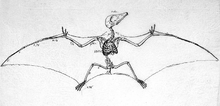
Contrary to von Moll's report, the fossil was not missing; it was being studied by Samuel Thomas von Sömmerring, who gave a public lecture about it on 27 December 1810. In January 1811, von Sömmerring wrote a letter to Cuvier deploring the fact that he had only recently been informed of Cuvier's request for information. His lecture was published in 1812, and in it von Sömmerring named the species Ornithocephalus antiquus.[16] The animal was described as being both a mammal, a bat, and a form in between mammals and birds, i.e. not intermediate in descent but in "affinity" or archetype. Cuvier disagreed, and the same year in his Ossemens fossiles provided a lengthy description in which he restated that the animal was a reptile.[17] It was not until 1817 that a second specimen of Pterodactylus came to light, again from Solnhofen. This tiny specimen was that year described by von Soemmerring as Ornithocephalus brevirostris (for its short snout, now understood to be a juvenile character), and provided a restoration of the skeleton, the first one published for any pterosaur.[13] This restoration was very inaccurate, von Soemmerring mistaking the long metacarpals for the bones of the lower arm, the lower arm for the humerus, this upper arm for the breast bone and this sternum again for the shoulder blades.[18] Von Soemmerring did not change his opinion that these forms were bats and this "bat model" for interpreting pterosaurs would remain influential long after a consensus had been reached around 1860 that they were reptiles. The standard assumptions were that pterosaurs were quadrupedal, clumsy on the ground, furred, warmblooded and had a wing membrane reaching the ankle.[19] Some of these elements have been confirmed, some refuted by modern research, while others remain disputed.

In 1998, the discovery of one specimen assigned to P. kochi shed light on the life appearance of Pterodactylus, as it preserved unique soft-tissue traits not present in previous fossil skeletons, including long, bristly pycnofibres (a fur-like body covering known only in pterosaurs) on the neck, details of an urpatagium (hind wing membrane between the legs and tail) that also stretched between the toes as webbing, and a pelican-like throat pouch.[6] An additional specimen, studied using ultra-violet light, revealed even more information on the soft anatomy of Pterodactylus. This specimen (catalog number JME SOS 4784) showed that like many other pterosaurs, Pterodactylus had a striated soft-tissue crest on the skull. Soft tissue impressions also showed unusually long, sharp, and recurved keratin sheaths on its claws. This specimen was also covered in hair-like pycnofibres, with unusually long pycnofibres covering the back of its neck. The remains of a small, hooked beak were preserved at the tips of the jaws between its upper and lower front teeth.[5]
Classification
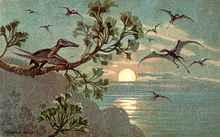
The genus now known as Pterodactylus was originally named Petro-Dactyle by Cuvier in 1809,[20] though this was a typographical error, later corrected by him to Ptéro-Dactyle.[13] In 1812, Samuel Thomas von Sömmerring named the same specimen Ornithocephalus antiquus. As the senior synonym, Cuvier's name has precedence, so applying modern rules for the combination of the genus name and the specific epithet, the valid species name became Ptéro-Dactyle antiquus. The genus name was Latinized to the current Pterodactylus by Constantine Samuel Rafinesque in 1815, which by these rules is the valid name as they do not allow for diacritics or hyphens. Unaware of Rafinesque's publication Cuvier himself in 1819 again Latinized the genus,[21] but the specific name he then gave, longirostris, has to give precedence to von Soemmerring's antiquus. In 1888 Richard Lydekker designated Pterodactylus antiquus the type species. The original specimen is the holotype of the genus, BSP No. AS.I.739.
Hermann von Meyer, in 1830, used the name Pterodactyli to contain Pterodactylus and other pterosaurs known at the time. This was emended to the family Pterodactylidae by Prince Charles Lucien Bonaparte in 1838. This family has more recently been used to refer to many similar species from Germany and elsewhere, though recent studies suggest it may be a paraphyletic or polyphyletic unnatural grouping with respect to more advanced members of the Ctenochasmatoidea (or Archaeopterodactyloidea).[22][23]
Species
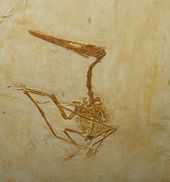
Numerous species have been assigned to Pterodactylus in the years since its discovery. In the first half of the nineteenth century any new pterosaur species would be named Pterodactylus, which thus became a typical "waste-basket taxon". Even after clearly different forms had later been given their own generic name, new species would be created from the very productive late Jurassic German sites, often based on only slightly different material.
Around 1980, subsequent revisions by Peter Wellnhofer had reduced the number of recognized species to about half a dozen. Many species assigned to Pterodactylus had been based on juvenile specimens, and subsequently been recognized as immature individuals of other species or genera. By the 1990s it was understood that this was even true for part of the remaining species. P. elegans, for example, was found by numerous studies to be an immature Ctenochasma.[4] Another species of Pterodactylus originally based on small, immature specimens was P. micronyx. However, it has been difficult to determine exactly of what genus and species P. micronyx might be the juvenile form. Stéphane Jouve, Christopher Bennett and others had once suggested that it probably belonged either to Gnathosaurus subulatus or one of the Ctenochasma species,[3][4] though after additional research Bennett assigned it to the genus Aurorazhdarcho.[7] Another species with a complex history is P. longicollum, named by von Meyer in 1854, based on a large specimen with a long neck and fewer teeth. Many researchers, including David Unwin, have found P. longicollum to be distinct from P. kochi and P. antiquus. Unwin found P. longicollum to be closer to Germanodactylus and therefore requiring a new genus name.[22] It has sometimes been placed in the genus Diopecephalus because Harry Govier Seeley based this genus partly on the P. longicollum material. However, it was shown by Bennett that the type specimen later designated for Diopecephalus was a fossil belonging to P. kochi, and no longer thought to be separate from Pterodactylus. Diopecephalus is therefore a synonym of Pterodactylus, and as such is unavailable for use as a new genus for "P." longicollum.[24] "P." longicollum was eventually made the type species of a separate genus Ardeadactylus.[7]
The only well-known and well-supported species left were P. antiquus and P. kochi. However, most studies since the 1990s have found little reason to separate even these two, and have treated them as synonymous.[22][24] In 1996, Bennett suggested that the differences between specimens of P. kochi and P. antiquus could be explained by differences in age. In a 2004 paper, Jouve used a different method of analysis and recovered the same result, showing that the "distinctive" features of P. kochi were age-related, and using mathematical comparison to show that the two forms are different growth stages of the same species.[4] An additional review of the specimens published in 2013 demonstrated that some of the supposed differences between P. kochi and P. antiquus were due to measurement errors, further supporting their synonymy.[7]
List of species and synonyms

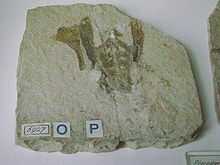
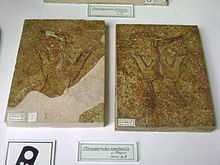
During its over 200 year history, the various species of Pterodactylus have gone through a number of changes in classification, and thus have acquired a large number of synonyms. Additionally, a number of species assigned to Pterodactylus are based on poor remains that have proven difficult to assign to one species or another, and are therefore considered nomina dubia ("doubtful names"). The following list includes names that are based on German material presently, or until recently, thought to be pertaining to Pterodactylus proper and names based on other material that has as yet not been assigned to other genera.
| Name | Author | Year | Status | Notes |
|---|---|---|---|---|
| Pterodactylus antiquus | (von Sömmerring) Rafinesque | (1812) 1815 | Valid, type species | Originally Ptéro-dactyle, Cuvier 1809 |
| Ornithocephalus antiquus | von Sömmerring | 1812 | Synonym of Pterodactylus antiquus | Objective junior synonym of P. antiquus |
| Ornithocephalus brevirostris | von Sömmerring | 1816–17 | Synonym of Pterodactylus antiquus | Based on a juvenile specimen |
| Ptenodracon brevirostris | (von Sömmerring) Lydekker | (1816–17) 1888 | Synonym of Pterodactylus antiquus | Reclassified from Pterodactylus brevirostris, based on a juvenile specimen |
| Pterodactylus brevirostris | (von Sömmerring) Oken | (1816–17) 1819 | Synonym of Pterodactylus antiquus | Name correction from Ornithocephalus brevirostris, based on a juvenile specimen |
| Pterodactylus longirostris | Cuvier | 1819 | Synonym of Pterodactylus antiquus |
– |
| Macrotrachelus longirostris | (Cuvier) Giebel | (1819) 1852 | Synonym of Pterodactylus antiquus | Reclassified from Pterodactylus longirostris |
| Ornithocephalus longirostris | (Cuvier) Ritgen | (1819) 1826 | Synonym of Pterodactylus antiquus | Incorrect name correction from Pterodactylus longirostris |
| Pterodactylus "suevicus" | Oken | 1825 | Synonym of Pterodactylus antiquus | Nomen nudum |
| Pterodactylus crocodilocephaloides | Ritgen | 1826 | Synonym of Pterodactylus antiquus | |
| Pterodactylus spectabilis | von Meyer | 1861 | Synonym of Pterodactylus antiquus | |
| Pterodactylus grandis | Cuvier | 1824 | Nomen dubium, possible synonym of Rhamphorhynchus muensteri | |
| Pterodactylus kochi | (Wagner) | (1837) | Synonym of Pterodactylus antiquus | Name correction from Ornithocephalus kochi |
| Ornithocephalus kochi | Wagner | 1837 | Synonym of Pterodactylus kochi | |
| Diopecephalus kochi | (Wagner) Seeley | (1837) 1871 | Synonym of Pterodactylus kochi | Reclassification of Pterodactylus kochi |
| Pterodactylus meyeri | Muenster | 1842 | Synonym of Pterodactylus kochi | |
| Ornithocephalus meyeri | (Muenster) Wagner | (1842) 1851 | Synonym of Pterodactylus kochi | Incorrect name correction from Pterodactylus meyeri |
| Pterodactylus scolopaciceps | von Meyer | 1850 | Synonym of Pterodactylus kochi | |
| Rhamphorhynchus scolopaciceps | (von Meyer) | (1850) | Synonym of Pterodactylus kochi | Reclassification of Pterodactylus scolopaciceps |
| Pterodactylus cerinensis | von Meyer | 1860 | Nomen dubium | |
| Pterodactylus grandipelvis | von Meyer | 1860 | Nomen dubium | |
| Pterodactylus manseli | Owen | 1874 | Nomen dubium | |
| Pterodactylus pleydelli | Owen | 1874 | Nomen dubium | |
| Pterodactylus suprajurensis | Sauvage | 1873 | Nomen dubium | |
| Pterodactylus arningi | Reck | 1931 | Nomen dubium | |
| Pterodactylus maximus | Reck | 1931 | Nomen dubium | |
References
- ↑ Schweigert, G. (2007). "Ammonite biostratigraphy as a tool for dating Upper Jurassic lithographic limestones from South Germany – first results and open questions". Neues Jahrbuch für Geologie und Paläontologie – Abhandlungen 245 (1): 117–125. doi:10.1127/0077-7749/2007/0245-0117.
- ↑ 2.0 2.1 2.2 2.3 2.4 2.5 Bennett, S.C. (1996). "Year-classes of pterosaurs from the Solnhofen Limestone of Germany: Taxonomic and Systematic Implications". Journal of Vertebrate Paleontology 16 (3): 432–444. doi:10.1080/02724634.1996.10011332.
- ↑ 3.0 3.1 Bennett, S.C. (2002). "Soft tissue preservation of the cranial crest of the pterosaur Germanodactylus from Solnhofen". Journal of Vertebrate Paleontology 22 (1): 43–48. doi:10.1671/0272-4634(2002)022[0043:STPOTC]2.0.CO;2. JSTOR 4524192.
- ↑ 4.0 4.1 4.2 4.3 4.4 4.5 Jouve, S. (2004). "Description of the skull of a Ctenochasma (Pterosauria) from the latest Jurassic of eastern France, with a taxonomic revision of European Tithonian Pterodactyloidea". Journal of Vertebrate Paleontology 24 (3): 542–554. doi:10.1671/0272-4634(2004)024[0542:DOTSOA]2.0.CO;2.
- ↑ 5.0 5.1 5.2 Frey, E., Tischilinger, H., Buchy, M.-C. and Martill, D.M. (2003). "New specimens of Pterosauria (Reptilia) with soft partes with implications for pterosaurian anatomy and locomotion. In: Buffetaut, E. and Mazin, J.-M. (eds.)". Evolution and Palaeobiology of Pterosaurs (London: Geological Society) 217: 233–266.
- ↑ 6.0 6.1 6.2 6.3 Frey, E., and Martill, D.M. (1998). "Soft tissue preservation in a specimen of Pterodactylus kochi (Wagner) from the Upper Jurassic of Germany". Neues Jahrbuch für Geologie und Paläontologie, Abhandlungen 210: 421–441.
- ↑ 7.0 7.1 7.2 7.3 7.4 7.5 Bennett, S. Christopher (2013). "New information on body size and cranial display structures of Pterodactylus antiquus, with a revision of the genus". Paläontologische Zeitschrift. in press. doi:10.1007/s12542-012-0159-8.
- ↑ Wellnhofer, P. (1970). Die Pterodactyloidea (Pterosauria) der Oberjura-Plattenkalke Siiddeutschlands. Bayerische Akademie der Wissenschaften, Mathematisch-Wissenschaftlichen Klasse, Abhandlungen, 141: 133 pp.
- ↑ Schmitz, L.; Motani, R. (2011). "Nocturnality in Dinosaurs Inferred from Scleral Ring and Orbit Morphology". Science 332 (6030): 705–8. doi:10.1126/science.1200043. PMID 21493820.
- ↑ Unwin, David M. (2006). The Pterosaurs: From Deep Time. New York: Pi Press. p. 246. ISBN 0-13-146308-X.
- ↑ Brougham, H.P. (1844). Dialogues on instinct; with analytical view of the researches on fossil osteology. Volume 19 of Knight's weekly vol.
- ↑ Collini, C A. (1784). "Sur quelques Zoolithes du Cabinet d’Histoire naturelle de S. A. S. E. Palatine & de Bavière, à Mannheim." Acta Theodoro-Palatinae Mannheim 5 Pars Physica, pp. 58–103 (1 plate).
- ↑ 13.0 13.1 13.2 13.3 Taquet, P., and Padian, K. (2004). "The earliest known restoration of a pterosaur and the philosophical origins of Cuvier's Ossemens Fossiles". Comptes Rendus Palevol 3 (2): 157–175. doi:10.1016/j.crpv.2004.02.002.
- ↑ Wagler, J. (1830). Natürliches System der Amphibien Munich, 1830: 1–354.
- ↑ Cuvier, G. (1801). "[Reptile volant]. In: Extrait d'un ouvrage sur les espèces de quadrupèdes dont on a trouvé les ossemens dans l'intérieur de la terre". Journal de Physique, de Chimie et d'Histoire Naturelle 52: 253–267.
- ↑ von Sömmerring, S. T. (1812). "Über einen Ornithocephalus oder über das unbekannten Thier der Vorwelt, dessen Fossiles Gerippe Collini im 5. Bande der Actorum Academiae Theodoro-Palatinae nebst einer Abbildung in natürlicher Grösse im Jahre 1784 beschrieb, und welches Gerippe sich gegenwärtig in der Naturalien-Sammlung der königlichen Akademie der Wissenschaften zu München befindet", Denkschriften der königlichen bayerischen Akademie der Wissenschaften, München: mathematisch-physikalische Classe 3: 89–158
- ↑ Cuvier, G. (1812). Recherches sur les ossemens fossiles. I ed. p. 24, tab. 31
- ↑ Sömmering, T. v. (1817). "Über einen Ornithocephalus brevirostris der Vorwelt". Denkschr. Kgl. Bayer Akad. Wiss., math.phys. Cl. 6: 89–104.
- ↑ Padian, K. (1987). "The case of the bat-winged pterosaur. Typological taxonomy and the influence of pictorial representation on scientific perception", pp. 65–81 in: Czerkas, S. J. and Olson, E. C., eds. Dinosaurs past and present. An exhibition and symposium organized by the Natural History Museum of Los Angeles County. Volume 2. Natural History Museum of Los Angeles County and University of Washington Press, Seattle and London
- ↑ Cuvier, G. (1809). "Mémoire sur le squelette fossile d'un reptile volant des environs d'Aichstedt, que quelques naturalistes ont pris pour un oiseau, et dont nous formons un genre de Sauriens, sous le nom de Petro-Dactyle". Annales du Muséum national d'Histoire Naturelle, Paris 13: 424–437.
- ↑ Cuvier, G., 1819, (Pterodactylus longirostris) in Isis von Oken, 1126 und 1788, Jena
- ↑ 22.0 22.1 22.2 Unwin, D. M., (2003). "On the phylogeny and evolutionary history of pterosaurs", pp. 139–190. in Buffetaut, E. & Mazin, J.-M., (eds.) (2003). Evolution and Palaeobiology of Pterosaurs. Geological Society of London, Special Publications 217, London, 1–347.
- ↑ Kellner, A.W.A. (2003). "Pterosaur phylogeny and comments on the evolutionary history of the group", pp. 105–137 in Buffetaut, E. and Mazin, J.-M., (eds.) (2003), Evolution and Palaeobiology of Pterosaurs. Geological Society of London, Special Publications 217, London: 1–347.
- ↑ 24.0 24.1 Bennett, S. Christopher (2006). "Juvenile specimens of the pterosaur Germanodactylus cristatus, with a review of the genus". Journal of Vertebrate Paleontology 26 (4): 872–878. doi:10.1671/0272-4634(2006)26[872:JSOTPG]2.0.CO;2.
External links
| Wikimedia Commons has media related to Pterodactylus. |
- The Pterosaur Database – Upper Jurassic Several species are discussed following individual links here.